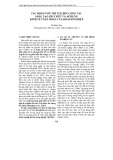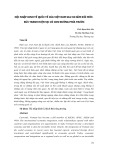
Chapter 34
The Influence of Monetary and Fiscal Policy On Aggregate Demand
TRUE/FALSE
1. Both monetary policy and fiscal policy affect aggregate demand.
ANS: T DIF: 1 REF: 34-0
NAT: Analytic LOC: Monetary and fiscal policy
TOP: Monetary policy | Fiscal policy MSC: Definitional
2. For the U.S. economy, the most important reason for the downward slope of the aggregate-demand curve is
the interest-rate effect.
ANS: T DIF: 2 REF: 34-1
NAT: Analytic LOC: Aggregate demand and aggregate supply
TOP: Interest-rate effect MSC: Interpretive
3. According to the theory of liquidity preference, the interest rate adjusts to balance the supply of, and demand
for, loanable funds.
ANS: F DIF: 2 REF: 34-1
NAT: Analytic LOC: The role of money
TOP: Theory of liquidity preference MSC: Interpretive
4. The theory of liquidity preference was developed by Irving Fisher.
ANS: F DIF: 1 REF: 34-1
NAT: Analytic LOC: The role of money
TOP: Theory of liquidity preference | Economists MSC: Interpretive
5. An increase in the money supply decreases the equilibrium interest rate and shifts the aggregate-demand curve
to the right.
ANS: T DIF: 2 REF: 34-1
NAT: Analytic LOC: Monetary and fiscal policy TOP: Monetary injections
MSC: Interpretive
6. Other things the same, an increase in the price level causes the real value of the dollar to fall in the market for
foreign-currency exchange.
ANS: F DIF: 2 REF: 34-1
NAT: Analytic LOC: Aggregate demand and aggregate supply
TOP: Exchange-rate effect MSC: Applicative
7. Changes in monetary policy aimed at reducing aggregate demand involve decreasing the money supply or
increasing the interest rate.
ANS: T DIF: 2 REF: 34-1
NAT: Analytic LOC: Monetary and fiscal policy TOP: Monetary policy
MSC: Interpretive
8. For the most part, fiscal policy affects the economy in the short run while monetary policy primarily matters in
the long run.
ANS: F DIF: 1 REF: 34-1
NAT: Analytic LOC: Monetary and fiscal policy
TOP: Fiscal policy | Monetary policy MSC: Interpretive
9. For a country such as the U.S., the wealth effect exerts a very important influence on the slope of the
aggregate-demand curve, since U.S. wealth is large relative to wealth in most other countries.
ANS: F DIF: 1 REF: 34-1
NAT: Analytic LOC: Monetary and fiscal policy TOP: Wealth effect
MSC: Interpretive
203

204 Chapter 34/The Influence of Monetary and Fiscal Policy On Aggregate Demand
10. If the inflation rate is zero, then the nominal and real interest rate are the same.
ANS: T DIF: 1 REF: 34-1
NAT: Analytic LOC: Monetary and fiscal policy
TOP: Nominal interest rate | Real interest rate MSC: Interpretive
11. In liquidity preference theory, an increase in the interest rate, other things the same, decreases the quantity of
money demanded, but does not shift the money demand curve.
ANS: T DIF: 1 REF: 34-1
NAT: Analytic LOC: Monetary and fiscal policy
TOP: Theory of liquidity preference MSC: Analytical
12. An increase in the price level shifts the money demand curve to the left, causing interest rates to increase.
ANS: F DIF: 1 REF: 34-1
NAT: Analytic LOC: Monetary and fiscal policy TOP: Money demand
MSC: Interpretive
13. An increase in the money supply shifts the aggregate-supply curve to the right.
ANS: F DIF: 1 REF: 34-1
NAT: Analytic LOC: Monetary and fiscal policy TOP: Monetary policy
MSC: Interpretive
14. When the Fed increases the money supply, the interest rate decreases. This decrease in the interest rate
increases consumption and investment demand, so the aggregate-demand curve shifts to the right.
ANS: T DIF: 2 REF: 34-1
NAT: Analytic LOC: Monetary and fiscal policy
TOP: Monetary policy | Aggregate-demand curve MSC: Analytical
15. Stock prices often rise when the Fed raises interest rates.
ANS: F DIF: 1 REF: 34-1
NAT: Analytic LOC: Monetary and fiscal policy
TOP: Stock market | Monetary policy MSC: Interpretive
16. When the Fed announces a target for the federal funds rate, it essentially accommodates the day-to-day
fluctuations in money demand by adjusting the money supply accordingly.
ANS: T DIF: 2 REF: 34-1
NAT: Analytic LOC: Monetary and fiscal policy
TOP: Federal funds rate | Monetary policy MSC: Interpretive
17. If the marginal propensity to consume is 6/7, then the multiplier is 7.
ANS: T DIF: 2 REF: 34-2
NAT: Analytic LOC: Monetary and fiscal policy TOP: Multiplier effect
MSC: Applicative
18. If the marginal propensity to consume is 4/5, then a decrease in government spending of $1 billion decreases
the demand for goods and services by $5 billion.
ANS: T DIF: 2 REF: 34-2
NAT: Analytic LOC: Monetary and fiscal policy TOP: Multiplier effect
MSC: Applicative
19. Both the multiplier effect and the investment accelerator tend to make the aggregate-demand curve shift
further than it does due to an initial increase in government expenditures.
ANS: T DIF: 1 REF: 34-2
NAT: Analytic LOC: Monetary and fiscal policy TOP: Multiplier effect | Investment
MSC: Applicative
20. The multiplier is computed as MPC / (1 - MPC).
ANS: F DIF: 1 REF: 34-2
NAT: Analytic LOC: Monetary and fiscal policy TOP: Multiplier effect
MSC: Definitional

Chapter 34/The Influence of Monetary and Fiscal Policy On Aggregate Demand 205
21. Permanent tax cuts have a larger impact on consumption spending than temporary ones.
ANS: T DIF: 1 REF: 34-2
NAT: Analytic LOC: Monetary and fiscal policy TOP: Taxes
MSC: Applicative
22. Some economists, called supply-siders, argue that changes in the money supply exert a strong influence on
aggregate supply.
ANS: F DIF: 2 REF: 34-2
NAT: Analytic LOC: Monetary and fiscal policy TOP: Supply-side economics
MSC: Applicative
23. In principle, the government could increase the money supply or increase government expenditures to try to
offset the effects of a wave of pessimism about the future of the economy.
ANS: T DIF: 1 REF: 34-3
NAT: Analytic LOC: Monetary and fiscal policy
TOP: Stabilization policy | Expectations MSC: Applicative
24. The main criticism of those who doubt the ability of the government to respond in a useful way to the business
cycle is that the theory by which money and government expenditures change output is flawed.
ANS: F DIF: 2 REF: 34-3
NAT: Analytic LOC: Monetary and fiscal policy TOP: Stabilization policy
MSC: Definitional
25. A significant lag for monetary policy is the time it takes to for a change in the money supply to change the
economy. A significant lag for fiscal policy is the time it takes to pass legislation authorizing it.
ANS: T DIF: 1 REF: 34-3
NAT: Analytic LOC: Monetary and fiscal policy TOP: Stabilization policy
MSC: Definitional
26. Unemployment insurance and welfare programs work as automatic stabilizers.
ANS: T DIF: 1 REF: 34-3
NAT: Analytic LOC: Monetary and fiscal policy TOP: Automatic stabilizers
MSC: Definitional
27. Depending on the size of the multiplier and crowding-out effects, the rightward shift in aggregate demand
from a tax cut could be larger or smaller than the tax cut.
ANS: T DIF: 2 REF: 34-3
NAT: Analytic LOC: Monetary and fiscal policy TOP: Multiplier effect
MSC: Analytic
28. During recessions, unemployment insurance payments tend to rise.
ANS: T DIF: 2 REF: 34-3
NAT: Analytic LOC: Monetary and fiscal policy TOP: Automatic stabilizers
MSC: Interpretive
29. During recessions, the government tends to run a budget deficit.
ANS: T DIF: 1 REF: 34-3
NAT: Analytic LOC: Monetary and fiscal policy TOP: Automatic stabilizers
MSC: Applicative
30. An implication of the Employment Act of 1946 is that the government should respond to changes in the
private economy to stabilize aggregate demand.
ANS: T DIF: 2 REF: 34-3
NAT: Analytic LOC: Monetary and fiscal policy TOP: Employment Act of 1946
MSC: Interpretive

206 Chapter 34/The Influence of Monetary and Fiscal Policy On Aggregate Demand
SHORT ANSWER
1. What is the difference between monetary policy and fiscal policy?
ANS:
The Federal Reserve Bank conducts U.S. monetary policy. It consists of policies to affect the financial side of the
economy-most notably the supply of money in the economy. Fiscal policy is conducted by the executive and
legislative branches of government, and entails decisions about taxes and government spending.
DIF: 2 REF: 34-1 NAT: Analytic
LOC: Monetary and fiscal policy TOP: Fiscal policy | Monetary policy
MSC: Definitional
2. There are three factors that help explain the slope of the aggregate demand curve. Which two are less
important? Why are they less important?
ANS:
The wealth effect and the exchange-rate effect are less important than the interest-rate effect in the United States.
The wealth effect is not very important because it operates through changes in the real value of money, and money
is only a small fraction of household wealth. So it is unlikely that changes in the price level will lead to large
changes in consumption spending through this channel. The exchange-rate effect is not very important in the United
States because trade with other countries represents a relatively small fraction of U.S. GDP. So a change in net-
exports due to a change in the exchange rate is likely to have a relatively small impact on real GDP.
DIF: 2 REF: 34-1 NAT: Analytic
LOC: Monetary and fiscal policy TOP: Wealth effect | Exchange-rate effect
MSC: Analytical
3. Explain why the interest rate is the opportunity cost of holding currency. What is the benefit of holding
currency?
ANS:
The nominal interest rate on currency is zero. The next best alternative is to buy a bond and earn interest. Currency
is used as a medium of exchange. Bonds are illiquid and so are costly to convert to a medium of exchange.
DIF: 2 REF: 34-1 NAT: Analytic
LOC: Monetary and fiscal policy TOP: Currency | Interest rates
MSC: Interpretive
4. Describe the process in the money market by which the interest rate reaches its equilibrium value if it starts
above equilibrium.
ANS:
If the interest rate is above equilibrium, there is an excess supply of money. People with more money than they want
to hold given the current interest rate deposit the money in banks and buy bonds. The increase in funds to lend out
causes the interest rate to fall. As the interest rate falls, the quantity of money demanded increases, which tends to
diminish the excess supply of money.
DIF: 3 REF: 34-1 NAT: Analytic
LOC: Monetary and fiscal policy TOP: Money market
MSC: Analytical
5. Use the money market to explain the interest-rate effect and its relation to the slope of the aggregate demand
curve.
ANS:
When the price level falls, people need less money for their transactions. The decreased demand for money leads to
a decrease in interest rates as money demand shifts left. Lower interest rates encourage consumption and investment
spending. Thus, a decrease in the price level raises the aggregate quantity of goods and services demanded.
DIF: 2 REF: 34-1 NAT: Analytic
LOC: Monetary and fiscal policy TOP: Interest-rate effect
MSC: Analytical

Chapter 34/The Influence of Monetary and Fiscal Policy On Aggregate Demand 207
6. Explain the logic according to liquidity preference theory by which an increase in the money supply changes
the aggregate demand curve.
ANS:
When the money supply increases, the interest rate falls. As the interest rate falls people will want to spend more
and firms will want to build more factories and other capital goods. This increase in aggregate demand happens for
any given price level, so aggregate demand shifts right.
DIF: 2 REF: 34-1 NAT: Analytic
LOC: Monetary and fiscal policy TOP: Monetary policy | Aggregate-demand curve
MSC: Analytical
7. How does a reduction in the money supply by the Fed make owning stocks less attractive?
ANS:
The reduction in the money supply raises the interest rate. So the return on bonds increases relative to the return on
stocks. The increase in the interest rate also causes spending to fall, so that revenues and profits fall, making shares
of ownership in corporations less valuable.
DIF: 2 REF: 34-1 NAT: Analytic
LOC: Monetary and fiscal policy TOP: Money supply | Stock market
MSC: Applicative
8. Suppose that the government spends more on a missile defense program. What does this do to aggregate
demand? How is you answer affected by the presence of the multiplier, crowding-out, taxes, and investment-
accelerator effects?
ANS:
The increase in expenditures means that government spending rises. The aggregate demand curve shifts to the right.
Aggregate demand shifts farther if there is a multiplier effect or an investment accelerator and shifts less if there is
crowding out or if taxes are raised to increase government expenditures.
DIF: 2 REF: 34-2 NAT: Analytic
LOC: Monetary and fiscal policy TOP: Multiplier effect | Crowding out | Investment
MSC: Interpretive
9. Suppose that there are no crowding-out effects and the MPC is .9. By how much must the government
increase expenditures to shift the aggregate demand curve right by $10 billion?
ANS:
An MPC of .9 means the multiplier = 1/(1 - .9) = 10. The increase in aggregate demand equals the multiplier times
the change in government expenditures. So to increase aggregate demand by $10 billion, the government would
have to increase expenditures by $1 billion.
DIF: 2 REF: 34-2 NAT: Analytic
LOC: Monetary and fiscal policy TOP: Multiplier effect
MSC: Analytical
10. Suppose that the government increases expenditures by $150 billion while increasing taxes by $150 billion.
Suppose that the MPC is .80 and that there are no crowding out or accelerator effects. What is the combined
effects of these changes? Why is the combined change not equal to zero?
ANS:
The multiplier is 1/(1-MPC) = 1/(1-.8) = 1/.2 = 5. The increase of $150 in government expenditures leads to a shift
of $150 billion x 5 = $750 billion in aggregate demand. The increase in taxes decreases income by $150 and so
initially decreases consumption by $150 billion x MPC = $150 billion x .8 = $120 billion. This change in
consumption will create a multiplier effect of $120 billion x 5 = $600. Thus the net change is $750 billion - $600
billion = $150 billion. The changes don’t cancel each other out, because a tax increase decreases consumption by
less than the tax increase.
DIF: 3 REF: 34-3 NAT: Analytic
LOC: Monetary and fiscal policy TOP: Multiplier effect | Taxes
MSC: Analytical













![Bài tập Kinh tế vi mô kèm đáp án [chuẩn nhất]](https://cdn.tailieu.vn/images/document/thumbnail/2025/20250923/thaovu2k5/135x160/19561758679224.jpg)












